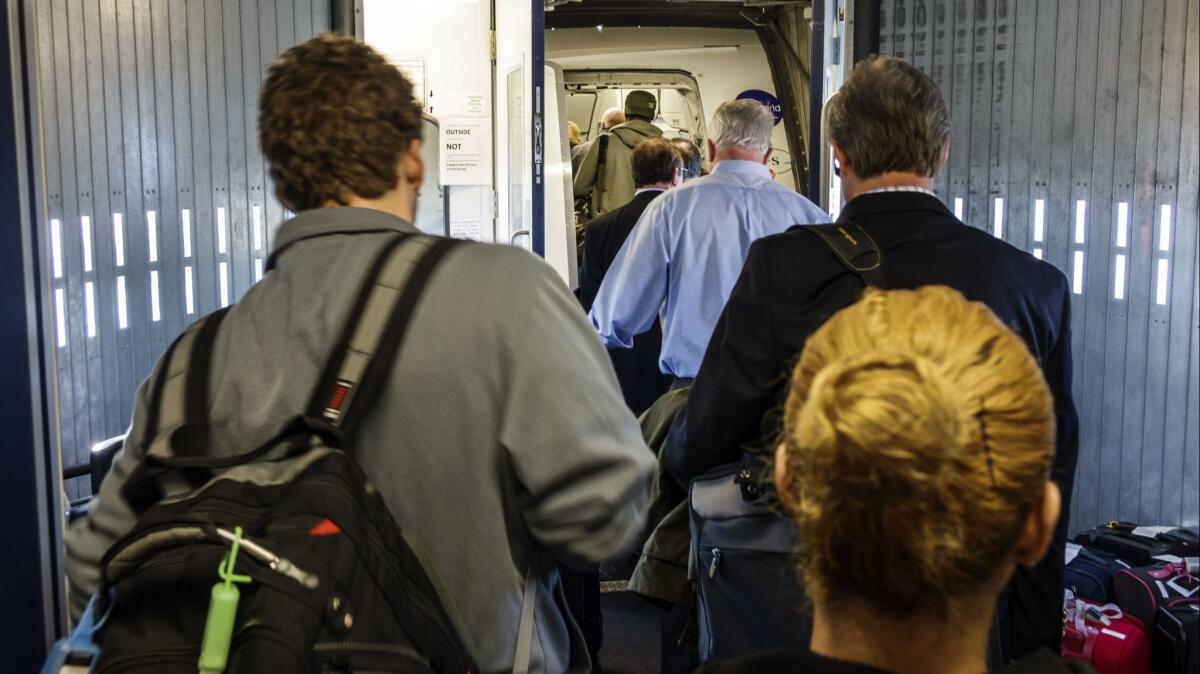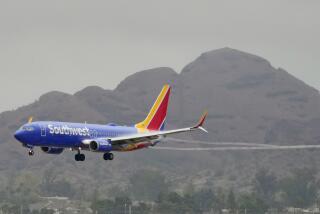Boarding an airplane is such a pain in the neck. Can the process be fixed?

- Share via
Question: Don’t you think it is strange that airplanes are still designed to be boarded from the front? And that airlines board the passengers starting with those sitting in the front rows?
Gary Kazanjian
Hermosa Beach
Answer: Don’t I think it’s strange? That’s such a wonderful straight line I can hardly contain myself.
But, no, it’s not all that strange, at least not when you consider everything that’s in play.
In fact, it’s almost a bit Shakespearean. Every boarding has drama (will someone sit in the middle seat in my row?), tension (room for my carry-on?), anger (stuck in middle seat), sorrow (stuck in middle seat by the restroom), joy (open seat in my row) and happiness (don’t have to do this again for another [fill in the blank until next trip]).
Because for the most part, boarding is a scrum, which Webster’s New World College Dictionary, fifth edition, describes as “a disorderly group of people crowded together often in pursuit of a person or thing.”
The “thing,” in this case, is a seat.
The issues are both in the boarding phase and in the moving-through-the-cabin phase. Here are some of the obstacles between you and that plain vanilla coach seat, which is where most of us fly.
Elite fliers or airline status
Brett Snyder, formerly an airline employee and now president of CrankyFlier.com, which deals with airline questions, and CrankyConcierge.com, which offers air travel assistance, referred to the status issues as “carve-outs.”
“While there have been studies that tried to prove the more efficient way to board, the airlines ended up having so many ‘carve-outs’ that it destroyed any efficiencies,” he said in an email.
“It’s not just first class, but it’s also elite members, credit card holders, people who have paid for priority boarding.”
Consider American Airlines, which revamped its boarding process about a year ago to comprise nine boarding groups.
Of the members of the first five groups, most have status in the airline’s frequent-flier program or its airline alliance frequent-flier program.
Group 1 is first class and active military with military ID, which makes sense.
But Groups 2-5 start to sound like a trip to the jewelry mart: platinum, emerald, sapphire, gold and ruby.
Some early boarders have bought their way into a more favorable place in line, and some have American Airlines credit cards (Groups 4 and 5, respectively).
Here’s how Groups 6, 7 and 8 are described:
Yes, that space is blank. No description.
Group 9 does have a description: It boards last because it consists of the basic economy passengers — the cheap seats, as it were. Many basic economy fliers are not allowed to put anything in the overhead.
Which leads us to obstacle No. 2:
Carry-ons
It takes time to heft that carry-on into the overhead as we tussle with bin-hog bags and shopping bags that are too full of our vacation loot.
“The increase during the past decade in the number of roll-aboard bags, related to bag fees, does seem to have slowed the [boarding] process,” said Seth Kaplan, managing partner for Airline Weekly, a trade publication.
“No airline has rescinded the checked-bag fees.”
Indeed, in 2016, we forked out more than $4 billion in bag fees.
Kaplan thinks that “the decision to check a bag or carry [a bag] on is more about convenience than price.”
Ah, yes, we’ll get to that below.
For now, wouldn’t it make sense, reader Lynn Cohen of Agoura Hills asked, if airlines boarded back to front (allowing for after-elite fliers)?
Carry-ons made that idea a nonstarter for United, thanks to bin issues.
“The feedback we got when we did this was if a customer went to the back of the aircraft and the bins were full, he or she would have to turn around to face a large line of people and try and navigate through that line to find a spot for their bag toward the front of the plane,” Maddie King, a United rep, said in an email.
The human variable
More than one airline representative told me that people get rattled during boarding, not surprising if there’s a mob behind you bearing down.
Fliers sit in the wrong seat, then have to squeeze by others to get to their seat (done that), drop something and have to retrieve it, thus blocking the aisle while crawling on hands and knees (done that), run quickly to the restroom and then find themselves like salmon swimming upstream (live in terror of doing that).
The truth is that any of these three categorical obstacles — elites, carry-ons and human foibles — can cause a problem. No airline boarding process goes even close to flawlessly.
Except maybe Southwest, which implemented its A, B, C, Nos. 1-30 and 31-60 process in 2007.
You line up by group and number. Somehow it works. If you try to jump the line, there is empirical evidence printed on your boarding pass of where you belong.
Then it’s open boarding; you don’t choose your seat until you board. Further, “boarding positions are determined by when you check in for your flight, a window [that] now begins online 24 hours before scheduled departure,” Dan Landson a rep for Southwest, said in an email.
“Since then, we’ve added a couple of a la carte products to fit the needs of customers who are happy to pay for either early check-in or guaranteed first-on-board, while protecting the integrity of the boarding process for others: our premium, Business Select fares guarantee an A1-A15 boarding position; our Early Bird product automatically checks in customers 36 hours before their flight.”
Southwest also doesn’t charge for bags, so although people still want the overheads, it’s a pretty easy decision to make if you don’t want to heft your roll-aboard into the bin.
And Southwest also allows boarding in some airports through the front and rear doors, which also speeds things up.
Relief for the rest of the issue may be on the way, though. Biometrics may solve at least the issue of the airline waiting area scrum sensation.
Several airlines are studying biometrics as a way to reduce the paper shuffle, fumbling, mumbling and grumbling in the waiting-to-get-on process.
Lufthansa is testing a system at LAX that employs biometrics, which has sped up its process. A camera snaps a photo, which is sent to Customs and Border Protection to match identifying information.
It takes about three seconds, said Bjoern Becker, head of ground products for Lufthansa Swiss and Austria groups.
“It’s way more convenient,” he said. “You just need your face.”
Which is convenient because you’ll always have that with you, no matter where you are.
Have a travel dilemma? Write to [email protected]. We regret we cannot answer every inquiry.
More to Read
Sign up for The Wild
We’ll help you find the best places to hike, bike and run, as well as the perfect silent spots for meditation and yoga.
You may occasionally receive promotional content from the Los Angeles Times.







